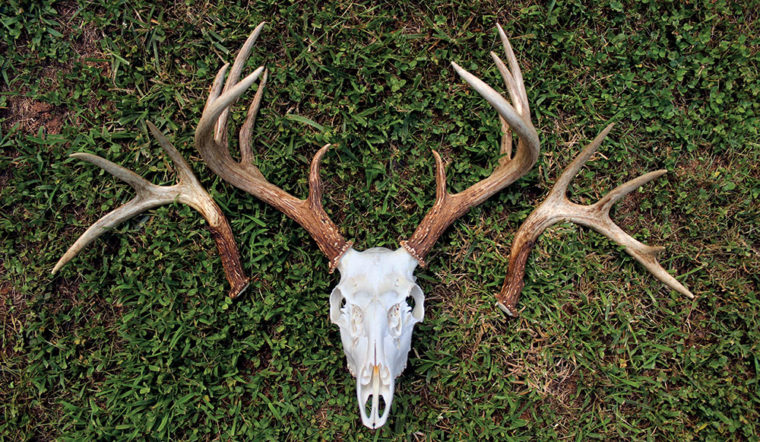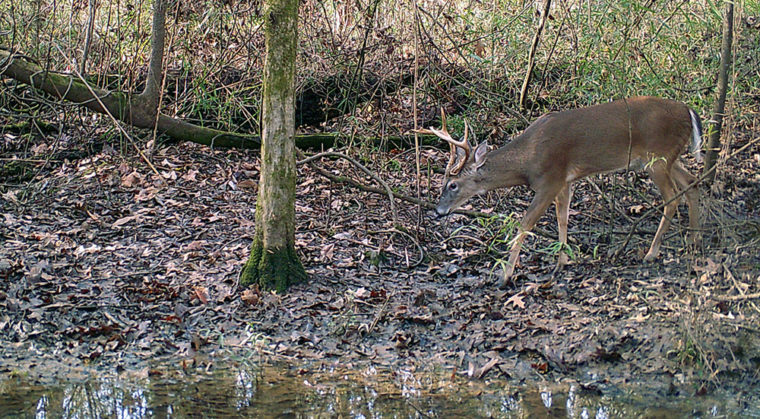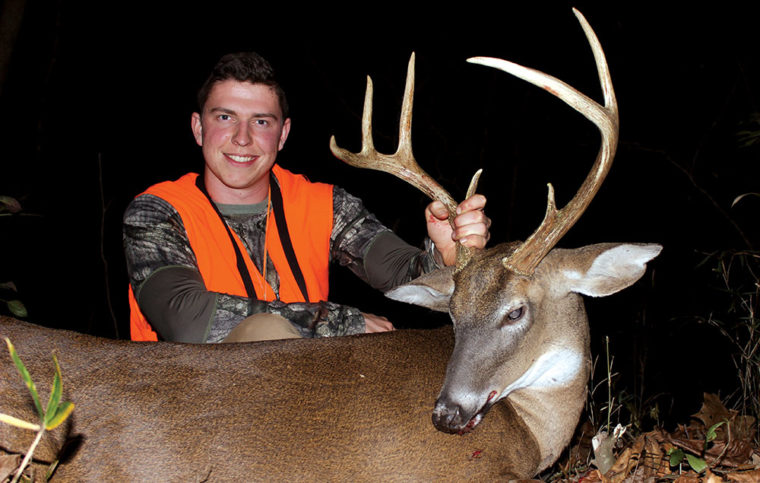Like many deer hunters, I grew up hunting small 10- to 20-acre private parcels. However, this all changed in fall 2018 when I moved from my home in North Carolina to attend college in central Mississippi and suddenly had access to over 100,000 acres of public land within an hour of my new house. This sudden change in my hunting environment has forever changed my perspective of public-land hunting opportunities as well as my hunting strategy.
Throughout my younger years, I heard horror stories of public-land difficulties such as few deer to hunt, small bucks, and dangerous hunting situations because of high hunter densities, but my public land experience the last two seasons has been far from this! In fact, I have learned more about deer hunting over the last two years and killed more quality deer than during all eight years of private-land hunting prior. Not only have my experiences on public land been very enjoyable and successful, but I now believe you can exercise voluntary harvest restraint on young bucks on public land with results.
Following are a couple stories from last fall where my familiarity and history with bucks on public land eventually led to successful harvests and a quality experience comparable to that of highly controlled private land holdings. Finally, I describe the notable characteristics of properties where I have found hunting success and strategies that have afforded me the opportunity to build history with bucks and eventually kill them.
Building History
My first season on Mississippi public land was very successful. I harvested a few bucks and does and watched numerous other deer that I did not shoot. In this region of the state, bucks must have at least a 10-inch inside spread or 13-inch main beams to be legal for harvest, however I routinely passed up 2½-year-old bucks that were legal by state regulations but younger than my personal harvest goal.
A few hunters on these wildlife management areas told me I was crazy for passing a legal buck on public land and that they would shoot these young deer if given the opportunity. However, I was determined to maintain the same standard for bucks on public land as I had developed while hunting private land in North Carolina: shooting only bucks that got my heart racing, typically a 3½-year-old deer or older.
Being a shed-hunting fanatic, I was excited to shed-hunt these public lands after hunting season was over and learn more about the quality of deer living there. In early March 2019, a buddy and I were shed-hunting some of these areas but having trouble finding deer that had already shed. On a whim, we decided to visit a piece of public land near my house that I had never visited. As we walked down the dirt access road toward a wheat food plot, we both simultaneously stopped and yelled “Shed!” A fresh 5-point side lay in the center of the road, just five feet from our boots! We picked it up and immediately began searching the rest of the forest block with the sudden burst of excitement that comes after finding a shed. We picked up five more fresh sheds that afternoon, including a 61-inch beast of a 4-point side. To say we were excited was an understatement. In four hours we had found six fresh sheds on public land!

It was exciting to find a matched set of shed antlers on public hunting land in 2018, especially since the right side was found as a “hanger” above the ground, Moriah’s first. Even better, the next year Moriah continued to get the buck on camera and eventually killed him with his muzzleloader. The public-land buck was estimated at 4½ years old based on toothwear, the oldest buck Moriah had ever killed on private or public land.
Just two weeks later, I found the matched side to the original shed we found in the road, 100 yards away from the first side. The matched side was particularly meaningful to me as it was stuck in a small Chinese privet bush and was not lying on the ground. It was my first “hanger,” a milestone for any shed hunter. Over the course of spring and summer I returned to this property to scout and learn more about it for fall hunts.
Reaping the Rewards
I was very excited to see the 2019 deer season arrive as I returned to many of the same properties I had hunted the year before. Rutting activity peaks during Christmas week in this area of Mississippi, so my anticipation was high as December rolled around. Due to travel and work commitments, I had not hunted Mississippi the last two weeks of November, but I finished work early the afternoon of December 5 and drove straight to a public area to hunt. I had seen several good deer on my trail-cameras on this property, passed on a few young bucks, and killed a nice buck on this property the year before.
I only had an hour to hunt, so I hiked three quarters of a mile from the car to a forest edge that had a lot of fresh rubs and scrapes adjacent to the point where a trail, leading from a switch-cane thicket, crossed a slough. Thirty minutes after sitting down on the ground against a tree with my muzzleloader, I heard deer running through the switch cane, and I readied my gun as I heard one slogging through the mud of the slough. A buck rose out of the slough and walked toward a clump of rubs nearby.
I sat like a statue against the base of the water oak just 20 yards away as he worked a scrape and made a new rub. Suddenly, he whipped his head around and stared daggers in my direction. I worried the gig may be up. Thirty seconds later he relaxed and let out a loud snort-wheeze and began walking. I stopped him as his vitals cleared the brush, and the shot hit him solidly in the chest.
I followed the blood trail 20 yards and recovered the buck with great excitement, but it wasn’t until I examined his rack more closely that I realized what had just happened. This mainframe 7-point was a buck I had on trail-camera during the 2018 season! He was easy to identify by the large forked antler with a brow tine on his left side. To make this harvest even more special, in 2018 I had seen him in person chasing does and had even passed on him. I couldn’t believe it, I had finally achieved a goal held since I began hunting: to build history with a buck, pass on him, and eventually kill him.

This 7-point buck was a regular visitor on Moriah’s trail-cameras during the fall of 2018, and Moriah even passed up a shot at him that fall as he chased does, even though he was legal then under state antler regulations. Returning to the same area in the early rut in fall 2019, Moriah killed the buck (photo at the top of this article) while hunting with a muzzleloader on the ground, proving that it’s possible to pass legal bucks on public hunting land and see them again the next year.
A few weeks later the rut was still heating up, and I began focusing on the property where we had found so many sheds the spring before. I was struggling to see deer while hunting, but the abundance of fresh rubs in the area and shooter bucks on my trail-camera encouraged me to keep hunting it. The afternoon of December 17 I decided to hunt a travel corridor created by a hardwood bottom between two blocks of young forest created by clearcuts from five years prior. I sat on the ground with my back against a small oak and waited, my muzzleloader ready.
As sunset approached, I had not seen a deer, but the sound of a snapping twig alerted me to a small spike that was walking toward me just 15 yards away. Soon, I heard the familiar sound of footsteps, and the spike whipped his head around to look back where he had come from. Then I saw him, a good buck walking the same trail as the spike and only 20 yards away. As I struggled to get my gun up, the spike caught my movement, snorted, and bounded away. The larger buck paused and watched the spike retreat while standing broadside. I settled the crosshairs and squeezed. As the smoke cleared, I could see the buck running away through the hardwoods.
I began searching the location of the shot and became ecstatic when I found a small piece of lung tissue lying on the ground and a blood trail leading up the hillside. One-hundred yards later I found the buck, a symmetrical 10-point that I had trail-camera pictures of! Upon inspection of his jawbone, I estimated he was a 4½-year-old buck, the oldest I had ever killed!
Later when I was home, I collected all the sheds we had found on the property and compared them to the antlers of my buck. I then realized the most special thing about this buck, I had his matched set from the year before! That’s right, his left side from 2018 was the first shed we had found on the property and his 2018 right side was the “hanger” I had found!
I was raised in a non-hunting family, and my first exposure to deer was through shed-hunting, which I discovered accidentally by stumbling upon a shed antler near my family’s house. So, shed-hunting has always been special to me, and I have always dreamed of finding sheds from a buck and later killing him. But never in my wildest dreams did I think this would happen on public land!
Public Land Strategies
I believe there are three factors that have been important to my ability to build history with bucks on public land, follow them yearly, and eventually kill them. These are hunting pressure, age structure, and habitat characteristics of the properties I choose to hunt. These factors may appear rather intuitive at face value, but bear with me as I explain how I have accounted for these factors while selecting properties to hunt.
At the time these hunts took place, I lived in Starkville Mississippi, a tiny college town that is home to Mississippi State University. Because of the university, there is a high density of young hunters needing a place to hunt, which means lots of pressure on public land. To account for this, I intentionally chose public tracts that are 15 to 30 minutes further away from Starkville than the closest public tracts, which reduces hunter density somewhat.
Areas that restrict weapons to archery, shotgun, or muzzleloader also become top choices for me, because these restrictions reduce pressure considerably. I further focus on tracts large enough that I can hunt at least three-quarters of a mile from the closest access point. This distance is my target minimum walk from the car, because it is where I typically begin seeing more deer sign and less hunter sign.
I have always dreamed of finding sheds from a buck and later killing him. But never in my wildest dreams did I think this would happen on public land!
Tracts that are large with little hunting traffic are only good if the deer are using them. So, I further refine target properties by walking them and evaluating habitat quality and the amount of deer sign present. Young forest stands, open sloughs that periodically flood, and switch-cane thickets have provided me the best hunting opportunities thus far. These areas provide cover and sometimes food that concentrate deer and deter hunting pressure because of poor visibility for long-range rifle shots.
Running many trail-cameras, hunting hard, and shed-hunting have allowed me to identify bucks, track them year to year, and even kill a few. I run about 10 trail-cameras across five public areas. While hunting, I always have an extra camera in my pocket so that if I discover a new spot with heavy deer sign, I can put up a camera. I try to place my cameras far from access points, usually following the same three-quarter-mile rule, and above eye level to reduce theft. I don’t check cameras often, and I rarely make hunting decisions based off trail-camera movement. I check them opportunistically every month or so in season and only when I am already visiting the area for a hunt. My reasoning is two-fold: I don’t want to blow deer out of the area, and I don’t have enough time to check all the cameras frequently. I use the information from my cameras to evaluate the quality of bucks in an area and monitor when deer use is highest throughout the season.
The more experience I have gained on these tracts, the more accurately I have been able to identify which hold the most mature bucks. Likely because of its statewide antler restrictions, Mississippi has an excellent buck age structure and leads the country in percentage of harvested bucks that are 3½ or older, according to QDMA’s 2020 Whitetail Report. While all states will not be equal in the quality of bucks on public land, across any state there will be some properties better suited for producing older age bucks than others. It will benefit you greatly to identify which properties produce the highest quality experience and then focus future effort there.
The “Public-Land Challenge”
I frequently hear people complain about public-land hunting, but the more I hunt public land, the more I have come to appreciate the incredible opportunity that is available to all. A move forced me to change from private parcels to public hunting areas, and this has improved my hunting confidence and success.
As an American hunter, you have access to hundreds of millions of acres to explore, hunt and embrace – because you are the owner. Having thousands of acres at your fingertips to scout and hunt forces you to grow as a hunter, and the opportunity to hunt quality deer and watch deer mature on these areas is very real. No, you do not need private property access to watch deer mature and enjoy quality hunting of them! So, why not go explore some public ground and begin making new memories?
